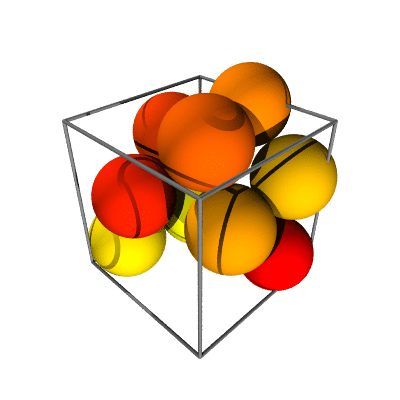Example Usage of spack¶
This is an ipython notebook in spack/docs/example-usage.ipynb,
demonstrating how to use spack.
First, we import our modules:
import spack
from math import pi
Now we put in some data.
The data below is from a simple packing I made using pyparm.packmin.
Normally you’d load your own data from a file.
L = 2.0066668050219723
diameters = [ 0.96, 0.97, 0.98, 0.99, 1. , 1.01, 1.02, 1.03, 1.04]
locs = [[ 1.40776762, 1.26647724, 0.73389219],
[ 0.58704249, 2.11399 , 1.52956579],
[ 1.75917911, 0.54290089, 1.27577478],
[ 2.13750384, 0.87508242, 0.21938647],
[ 1.07283961, 0.87692084, 1.9060841 ],
[ 0.09550267, 1.94404465, 0.56463369],
[ 1.07636871, 2.1942971 , 0.63752152],
[ 0.49922725, 1.20002224, 1.13360082],
[-0.27724757, 1.62152603, 1.67262247]]
Now we make the packing:
pack = spack.Packing(locs, diameters, L=L)
What does it look like?
size = 400
sc = pack.scene(rot=pi/4, camera_dist=2, cmap='autumn', bgcolor=[1,1,1])
sc.render('ipython', width=size, height=size, antialiasing=0.001)

Let’s make a movie!
from moviepy.editor import VideoClip
import moviepy.editor as mpy
duration = 10
def make_frame(t):
return (
pack.scene(rot=(t/duration + .125)*2.*pi,
camera_dist=2, cmap='autumn', bgcolor=[1,1,1])
.render(width=size, height=size, antialiasing=0.001)
)
vc = VideoClip(make_frame, duration=duration)
Write the movie to file. This takes about 10 minutes on my machine to render all 240 frames, but it does give you some pretty spiffy output.
vc.write_gif("example-packing.gif",fps=24)
[MoviePy] >>>> Building file example-packing.gif
[MoviePy] Generating GIF frames...
[MoviePy] Optimizing the GIF with ImageMagick...
[MoviePy] >>>> File example-packing.gif is ready !
And display the movie, in an ipython notebook.
from IPython.display import Image
Image(url="example-packing.gif")
